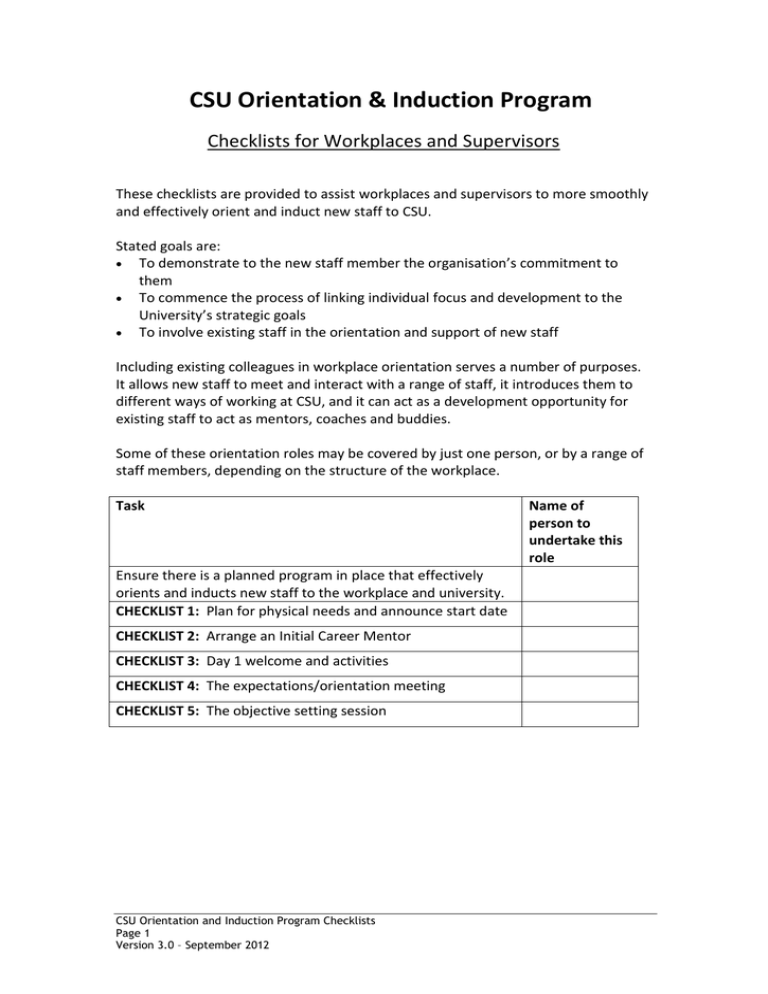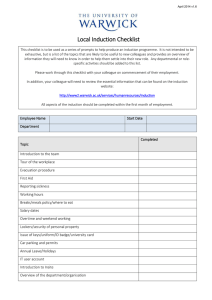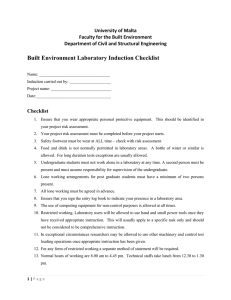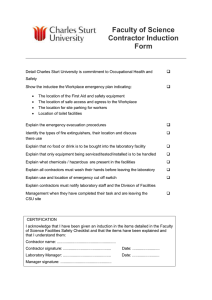Checklist 1: Before the new staff member starts
advertisement

CSU Orientation & Induction Program Checklists for Workplaces and Supervisors These checklists are provided to assist workplaces and supervisors to more smoothly and effectively orient and induct new staff to CSU. Stated goals are: To demonstrate to the new staff member the organisation’s commitment to them To commence the process of linking individual focus and development to the University’s strategic goals To involve existing staff in the orientation and support of new staff Including existing colleagues in workplace orientation serves a number of purposes. It allows new staff to meet and interact with a range of staff, it introduces them to different ways of working at CSU, and it can act as a development opportunity for existing staff to act as mentors, coaches and buddies. Some of these orientation roles may be covered by just one person, or by a range of staff members, depending on the structure of the workplace. Task Ensure there is a planned program in place that effectively orients and inducts new staff to the workplace and university. CHECKLIST 1: Plan for physical needs and announce start date CHECKLIST 2: Arrange an Initial Career Mentor CHECKLIST 3: Day 1 welcome and activities CHECKLIST 4: The expectations/orientation meeting CHECKLIST 5: The objective setting session CSU Orientation and Induction Program Checklists Page 1 Version 3.0 – September 2012 Name of person to undertake this role Checklist 1: Plan for physical needs and announce start date Make sure the new employee’s work space is available and clean, including arranging for keys and name plates for door (if applicable). Order any required furniture or equipment: liaise with HR if the employee has identified workplace adjustment needs. Purchase basic office supplies and place these on the new employee’s desk. Order computer equipment if needed, and request all computer software to be loaded on the computer. Confirm that the staff members log in id is operational. Ensure telephone is operational, previous voice mail is cleared, and a guide to the telephone and voice mail system is on the employee’s desk. If required, obtain forms and commence the process of ordering a mobile phone, corporate credit card and business cards. Provide Handbook for Staff in Schools (if applicable) and save relevant reading materials (e.g. policies and procedures) onto S drive for new staff member. Advise existing staff of the new employee’s start date, background, position title, and the range of duties that you expect he/she will be performing. If the employee is to be part of a committee or decision-making forum, advise this group of his/her commencement, and obtain a meeting schedule to be placed on the employee’s desk. Pre-employment contact – ensure the new employee is contacted to welcome him/her to the work unit, answer any initial questions he/she may have, and advise where to report on Day 1. Confirm that the new employee has the link to the online orientation and induction (www.csu.edu.au/induction) which can be started prior to commencement if the employee wishes. CSU Orientation and Induction Program Checklists Page 2 Version 3.0 – September 2012 Checklist 2: Arrange an Initial Career Mentor Outcome Support and encouragement are provided to the new employee, to enable him/her to develop role skills and effective working relationships. Purpose The Initial Career Mentor is a support resource that is offered to all staff new to a role. He/she advises and assists the new employee in the early stages of orientation into the new role. The period of this support will be mutually determined in conjunction with the new employee’s development needs. Process Whilst some content knowledge is assumed, role expertise is not as critical as coaching skills. The primary role is to encourage the development of the new employee as a valued member of the workplace. Resources to assist the Initial Career Mentor are available here and here. Ideally the initial career mentor should NOT be the new employee’s direct supervisor. The initial career mentor should: Meet with the new employee on Day 1 to outline the support relationship. Participate in welcoming activities. Link the new employee to people and resources which will assist his/her development. Act as a sounding board to “bounce around” ideas. Act as a guide and be willing to share information. Be inclusive of the newcomer in your work practices. Encourage a focus on reflective practice. Discuss any stress associated with the new position. (Role conflict is common when learning a new job, balancing work and social tensions associated with moving to a new city, and/or creating a new sense of professionalism). Discuss coping behaviours. CSU Orientation and Induction Program Checklists Page 3 Version 3.0 – September 2012 Checklist 3: Day 1 - Welcome and Activities Outcome The new employee is welcomed by his/her manager and colleagues, and is made aware of what he/she can expect over the first few weeks of employment. Approximately 3 hours also needs to be allocated during the first day/s for the employee to begin working through their Online Orientation and Induction. Purpose To introduce new staff into a welcoming atmosphere, by helping them to feel included in the work team and demonstrating that we value them as team members in our organisation. To allow new staff time to begin to work through their online Orientation and Induction process. Process Welcome by the immediate supervisor. (Please remember to discuss immediate issues such as hours of attendance, breaks, reporting and taking leave, the policy on smoking, etc. and provide an outline of orientation activities that have been arranged). Meet with the Initial Career Mentor (to discuss his/her role as an access point for the new employee to seek related information). Arrange for a colleague to show the new employee around the immediate work location and amenities (on Day 1) and the surrounding buildings and grounds. This should include fire exits, evacuation procedures, first aid resources, and other related OHS information. Arrange a welcome activity (e.g. coffee with peers, morning tea meeting). Arrange orientation with administrative staff (e.g. show the location and usage of equipment, security systems, keys, access to buildings, phone and voice mail systems, internal mail, stationery, printing, waste disposal.) Make arrangements for the issue of a corporate card (Diners Card), if applicable. Give the new employee access to the above Online Orientation and Induction so that they can begin to work through it. (Note: CSU log in is NOT required to access most parts) CSU Orientation and Induction Program Checklists Page 4 Version 3.0 – September 2012 Checklist 4: Week 1 - The Expectations/Orientation Meeting Outcome The manager meets with the new employee in the first week to help him/her understand the role and performance expectations. A meeting should also be arranged with the employee’s indirect supervisor so that the employee feels a level of approachability with the person one level above you. Purpose Mastering tasks or learning skills can make little sense in the early days of a new employee’s work without a context and understanding of why he/she is learning to do something and how he/she will work with other staff. The orientation meeting will help overcome role ambiguity by clearly explaining to the new employee the position requirements and what is expected of him/her as a member of staff. Managers should aim to make the job as manageable as possible, and make conditions as predictable and controllable as possible, until the new employee adapts to working in the organisation. This will help avoid role overload. Process For academic staff, this process is described here. For general staff, please see below: Define the job accurately and completely and check that the employee understands it. Explain the new employee’s role in the work unit. (E.g. Why is the work so important? What special contribution will he/she be making? What is the structure of the work area, organisational charts, workplace reporting relationships?) Explain the role in the context of the organisation. How does the employee’s work fit in with the completed product or service? How does it link to the work of other parts of the University? Explain specific compliance requirements relevant to the new employee’s role. (NOTE: These are extensively covered in the online orientation and induction). Discuss the probationary process and requirements and establish the links to the objective setting discussion, probationary process and future links to performance management. Talk about role expectations and performance standards and the development available to help the employee develp organisational knowledge and skills. Set a date for the objective setting session, and give the employee access to the general probation objective setting template, so that they can prepare in advance. CSU Orientation and Induction Program Checklists Page 5 Version 3.0 – September 2012 Checklist 5: Week 6 - The objective setting discussion Outcome Personal objectives to meet the identified priority development needs of the new employee are set. Purpose This session allows the new employee to feel confident in understanding what is expected of him/her, and how to meet these expectations. For continuing and fixedterm general staff appointments, these objectives will guide the employee’s development during his/her probationary period. Process For academic staff, this process is reflected here. 6 weeks after the employee commences work, a formal planning session is held to complete general probation objective setting template. Expectations of the new employee’s performance are reviewed, personal objectives are set; and resources and activities to meet his/her development needs are identified. For internal transfers, secondments and appointments, this stage will involve a review of his/her existing performance management plans. Review the expectations and requirements of the role and agree on the employee’s current performance in relation to these expectations. It is recommended to have the new employee perform a self-assessment prior to the meeting so that he/she can also suggest his/her own developmental needs. Negotiate and prioritise the employee’s development needs and identify the appropriate resources to meet these needs. Negotiate and set personal objectives for the new employee. For general staff, these are set for their induction and development period. For academic staff, these objectives are set for the coming 3- 18 months depending on the length of academic probation. Advise periodic arrangements for informal and formal opportunities for the new employee to receive feedback on his/her progress towards their objectives. Encourage reflective practices so that the new employee can reflect on his/her progress and achievements in relation to the objectives. Reinforce the value of becoming a reflective and self-directed practitioner. Review the following information to ensure the employee has the opportunity to clarify the processes and his/her responsibilities regarding: Probation; Induction Research, professional practice and teaching active criteria (academic staff). CSU Orientation and Induction Program Checklists Page 6 Version 3.0 – September 2012


